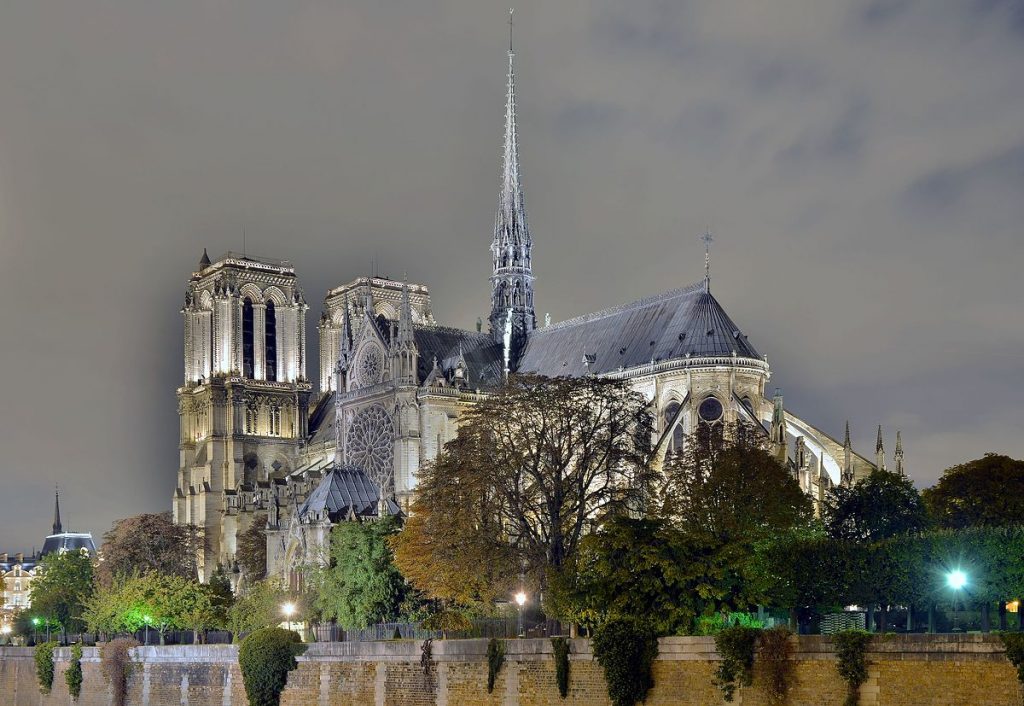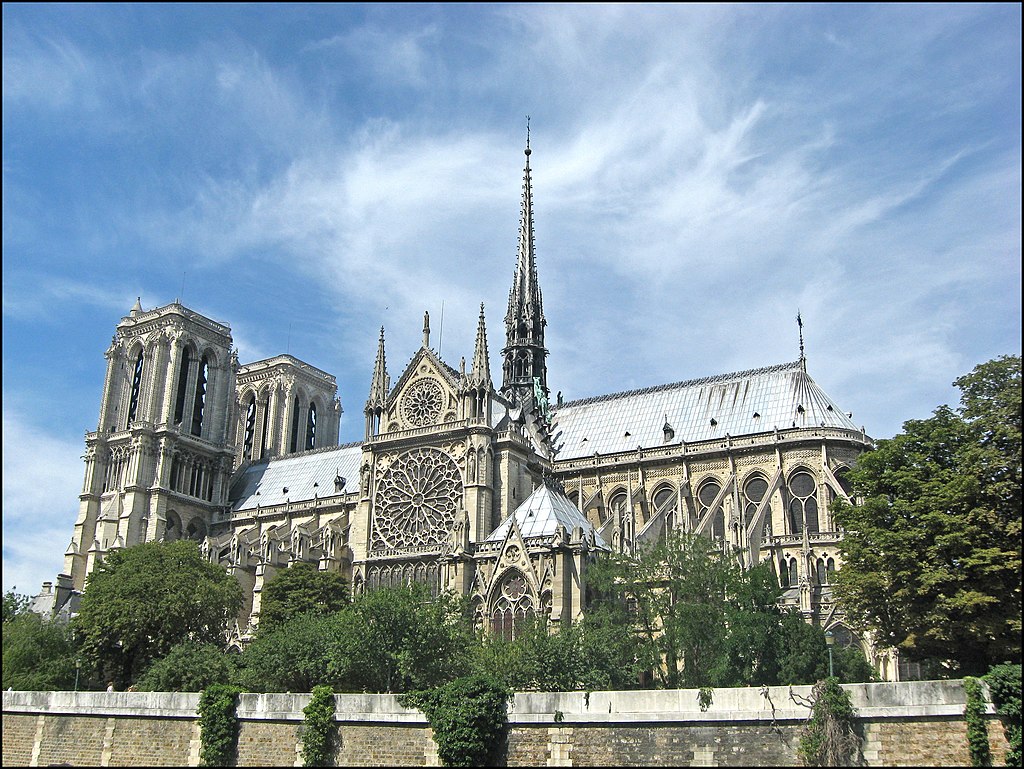Along with history, another subject I’m quite fond of is architecture, and one particular class of building design that captivates me is the “Medieval Gothic” style, predominantly French Gothic architecture, and no building in the world best demonstrates this than Notre-Dame de Paris. The beauty of the building is absolutely indescribable, and it’s been something I’ve loved since I was a child.

As I’ve grown older, I’ve grown to appreciate the history of the building as much as its sheer beauty. At over 800 years old, the building has been around for far longer than most anything I can think of that’s been in similar continued use and has been as critical to history in Europe as it has been. The building is effectively not just the center of Paris but of France, and in some ways for a time was the “center” of Europe during a bit of a split of the Catholic Church between branches in Paris and Rome.

Now, I’m not religious in the slightest – let alone Catholic, but I can still appreciate the significance of the building in the Churches history, the relics held within, and beyond that the importance the building has held to Paris, France, and Europe in general – centuries more history has passed with it standing tall, while here in the United States the oldest buildings barely break 300 years or so, and have very little history to show for it by comparison. This ignoring that we seem to be a culture that knocks down old buildings for new ones every 30-60 years, just because.
I say all this in short form to establish how much I genuinely care about this building – a feeling that can only be described as an absolute love for the structure as much as one can (sanely) care for a building.
Before I go further, I also have to mention that the Gargoyles on the building are pretty awesome. I’ve had a love of gargoyles in most any form since my early childhood (even having one which, mysteriously, has never gotten lost, or damaged over the years) and with Notre-Dame being covered in them (many functioning as water spouts, others just as decoration) I naturally love it.

This extends to all the religious symbology and artwork on and in the building. The portals depicting so much of theology in a “poor people’s book” form, the stained glass, the statues both within and without, it’s all so incredible and unique.
You can imagine then yesterday, when I learned of the fire raging on her roof my reaction. At first I thought it was a still important, but small scale event. I would quickly learn how wrong I was when news came that the spire had collapsed and the entire roof apparently was a conflagration.
I began to panic, fearing the complete obliteration of this amazing structure, a tangible aspect of nearly a millennia of human history reduces to ashes and charred brickwork.

All I could do was watch a news feed from the BBC and cry. Yes, I cried. It’s my nature to care deeply about history, about our cultural heritage as humans, and when that is combined with my incredible appreciation of this beautiful expression of design from a long bygone era, all I could do was weep.
I wasn’t alone in this. A close friend of mine had the same reaction, describing Notre-Dame as her “favorite spot on Earth.” She had the amazing fortune to be able to visit the Cathedral late last year and while she chose not to go inside (the lines are quite long to get in to visit and tour) she did get to take what photos she could and even capture some video of the exterior with the sound of the bells ringing. She shared it yesterday with the caption “Mon cœu” – My Heart.

For a certain type of person, for whatever reason, we have grown to simply adore that building, and all of us around the world could do nothing but watch the roof burn
Night fell quickly, limiting what we could see even more. The spire fell early on, giving us a hint at the damage that could be happening to the interior. Still, given the nature of things there was no aerial footage, save for one post on twitter which came across our radar. It painted a terrifying picture of what looks like effectively hell opening inside the building. We feared the worst, as did those fighting the fire.
It then was said that there were fears that the flames would move to the bell towers. Indeed, flames were spotted inside of one of them, but they didn’t intensify. This was a great concern not just due to fire damage on a whole, but the fact that were the fire to reach the bell towers and burn for long enough, down would come the bells, the largest of which, Emmanuel, weighs 13271 kilograms! Were that bell alone to fall it would likely have taken much of the tower with it in some way.

Heat too was critical, given the stonework that the superstructure of the cathedral was built from. Stone can only take so much heat, and fears were the heat alone would weaken the structure, leading to collapse.
A few hours into the fire, my friend messaged me updating me that they declared the building saved, which afforded me my first chance to somewhat relax during this ordeal. The fire was slowly, but surely, being put out, and soon we would know the actual extent of the damage which, thankfully, was nowhere near as bad as many of us feared.

This is partially due to coincidence, as many objects were moved (such as statues on the roof near the spire) for the restoration efforts which were being done. Had this fire happened even just a few weeks prior, the losses could have been much greater.
As it would turn out, this was basically an attic fire – the 13th century wood which formed the support structure for the lead roof somehow caught fire and once started it didn’t stop. This caused the roof (and as part of the roof structure, the spire) to collapse, but thankfully it fell, for the most part, onto the stonework of the vaulted ceiling. Still, a few holes were formed with material falling into the nave of the cathedral, but the interior did not ignite.

Interior damage certainly seems to be far less than what many feared, but even so, many artifacts within were rescued early on and were spared evn a chance of being damaged. While, again, I’m not religious in any capacity, I still value the historic identity placed on these objects and am incredibly happy that they were saved, as they still physically represent ideas which have been pivotal to the history of the western world.
The night of the fire the president of France stated that Notre-Dame would be restored. While the cost of repairing the damage will probably total into the billions and certainly will take many years, perhaps even over a decade to do, it will happen. Considering the age of the structure, this is but a blink of an eye in its history, and while it has never been damaged this badly in the past, this is still damage that can be recovered from. Somewhat ironic considering the building was in the process of having repair work done – in this case on the roof and spire – when the fire happened.

While there were many historic elements which were lost, predominantly the roof , much of what was feared to possibly be destroyed on the inside was saved. The Spire, perhaps the most vivid piece destroyed, was really only a few hundred years old, rebuilt over a century after the original one had been torn down due to it suffering its own damage over the centuries.
The pipe organs were only slightly damaged, and while there is some water and heavy soot damage around, as it would seem there isn’t as much actual destruction as people thought or feared.

The beautiful Rose Windows – probably my favorite features of the building – were originally feared lost, but were found after the fire to have survived. One of which has suffered frame damage (the frames of the stained glass windows being made of lead) and it will likely need repair. Still, it’s not damaged irreparably or destroyed (the windows which were destroyed were from the 19th century) and thus still exists to be appreciated once it’s repaired. I’m especially happy that the North Rose Windows (seen below) was saved, as it is truly one of the most incredible works of art I’ve ever seen.

“Photo by Julie Anne Workman. License: CC-BY-SA 3.0”
I stress this because for some reason, all across the internet, people are saying that the building was destroyed. It was not. Notre-Dame de Paris is still standing, and will be restored to its former glory. You cannot restore something which has been destroyed, as destroyed implies the effectively irreparable annihilation of the object as it was, that minimal, if any aspects of it are salvageable. The World Trade Center after 9/11 was destroyed. Notre Dame has simply been damaged. Heavily damaged, but it still exists. It hasn’t been destroyed in any form of the concept, so just stop saying that.
All I can end with is that I hope some fraction of the love I have for this building carried over in this article. It’s hard to describe, but easily thousands across the world, for whatever reason, felt the same way during this event. I could go on and on about this, and so many other things I’m passionate about, but I’ll leave my words at this for now.

To end, as always, Wikipedia links on both the Cathedral itself and on the fire. Please, I implore you if you care at all about the facts of this event to at least skim the fire article to learn what is known so far, at whatever time you access it.
https://en.wikipedia.org/wiki/Notre-Dame_de_Paris
https://en.wikipedia.org/wiki/Notre-Dame_de_Paris_fire
I hope down the line to be able to write more on this incredible building, hopefully celebration completion of the restoration when that day come.
Oh, lastly, why didn’t I write about this yesterday? Because I was exhausted, and I wanted to see the state of things 24 hours later, once they had stabilized.

